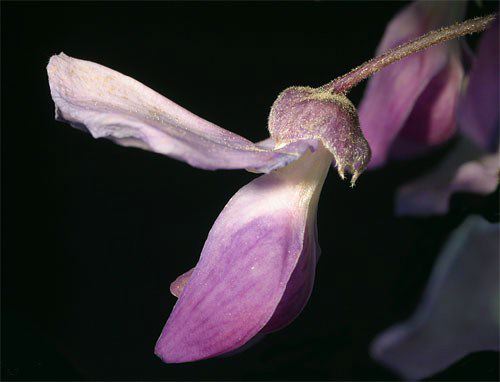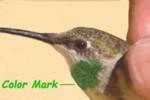|
|
|||
|
|
|||
Back to Preceding Week; on to Next Week
|
LOOK GOOD, SMELL BETTER, ACT BAD One of the great things about spring at Hilton Pond Center and most places in temperate North America is the sudden appearance of colorful blossoms after a relatively drab winter. This year's flower set--perhaps because of plentiful rain over the past several months--seems especially full, with a succession of Eastern Redbuds, Chickasaw Plums, and Flowering Dogwoods to brighten the landscape. One plant that seems to have an unusually heavy flower set this year smells good, looks even better, but acts very, very bad.  For the past few weeks, Piedmont treetops (including a few at Hilton Pond) have been festooned with an attractive blanket of pale white and purple--the unmistakable blossoms of Chinese Wisteria. This hardy vine--imported from Asia because of its rapid growth, eye-pleasing flowers, and dense foliage--may start out being the landscaper's friend, but fairly quickly it demonstrates why we should be ever so careful about flora we import and plant in our yards. Folks in the Southeastern U.S. are familiar with Kudzu, another Asian import that runs rampant over trees, telephone poles, old buildings, and slow-moving children. As bad as Kudzu is, Chinese Wisteria is even worse; Kudzu simply climbs and covers native trees and shrubs--occasionally shading them out and killing them---while Chinese Wisteria almost always strangles them to death. Wisteria is a twining vine, and when it wraps around a tree trunk the combined growth of vine and tree eventually chokes off the tree's plumbing. After the host tree rots away or topples earthward, the wisteria simply grows along the ground until the delicate tip of a new stem finds another vertical object to ascend, and the murderous cycle repeats itself. As its blossom reveals (top and above right), Chinese Wisteria, Wisteria sinensis, is in the five-petalled Pea Family (Fabaceae); members of the subfamily that contains wisterias have flowers in which one petal forms a hood over four others; two of these form "wings," and two others are fused to form a pouch or keel. Chinese Wisteria has been planted in North America as an ornamental since first imported in 1816, and it almost seems plausible that some of those original lianas could still be around. A mature Chinese Wisteria--whose vine is as hard and woody as many trees--can be 65 feet tall and 15" or more in diameter. (Such large growth usually occurs on cliffs or human-made structures, since a wisteria of this size likely would have killed its supportive plant host years ago.) Wisteria often branches at or near the surface of the ground, sending out runners in all directions and propagating vegetatively, but the prolific blooms also produce copious pollen--visible on the flower in the top photo--that fertilizes a neighboring blossom and results in distinctive velvety green pods containing shiny brown seeds (below). These seeds can be carried far downstream until entire watersheds are sometimes lined by native trees infested with Chinese Wisteria.
One problem with the importation of Chinese Wisteria is that horticulturists selected varieties that were robust and tolerant of a wide variety of soil and water regimes. In addition, they were careful NOT to bring along any of wisteria's natural diseases or insect pests. This strategy had a good aspect: At least they didn't introduce bugs that could have jumped to native North American flora; the downside is that there was nothing on this continent to keep wisteria populations in check. To make matters worse, Chinese Wisteria is not controlled initially by mechanical cutting--the remaining rootstock simply rears back and sends out ten times more shoots than before. Some native plant enthusiasts have had good luck with whacking back the same Chinese Wisteria every month for several years in a row, a strategy that eventually exhausts whatever reserves are stored in its roots. This is what we've been trying at Hilton Pond Center for the past 21 years, and we're finally starting to see some progress! Unfortunately, a former owner of the property seems to have planted sprigs of Chinese Wisteria in numerous spots around the property and it's about all we can do to locate and annihilate shoots as they emerge. Thus, each spring--despite our efforts--we always glance out through the woods and see a new cluster of blue Chinese Wisteria blossoms near the top of some tree that we somehow missed.
One effective method of control is to immediately treat a newly cut stem with strong herbicide; this would likely help us in our quest to eliminate Chinese Wisteria, but it's a technique we'd rather not use at the Center if we can avoid it. What we might do instead is purchase a bunch of American Wisteria, W. frutescens. This native wisteria is less aggressive than the foreign invader, and perhaps we could to teach it to wrestle with W. sinensis enough to slow down growth of the latter.
NOTE: Be sure to scroll down for an account of all birds banded or recaptured during the week, as well as some other interesting nature notes. "This Week at Hilton Pond" is written and photographed by Bill Hilton Jr., executive director of Hilton Pond Center for Piedmont Natural History. You may wish to consult our Index of all nature topics covered since February 2000. You can also use the on-line Search Engine at the bottom of this page. For a free, non-fattening, on-line subscription to "This Week at Hilton Pond," just send us an E-mail with Subscribe in the subject line. Please be sure to configure your spam filter to accept E-mails from hiltonpond.org. |
|
Make direct donations on-line through
Network for Good: |
|
|
LIKE TO SHOP ON-LINE?
Donate a portion of your purchase price from 500 top on-line stores via iGive: |
|
|
Use your PayPal account to make direct donations:
|
|
|
Participate in the  Please report your sightings of Please report your sightings ofColor-marked Ruby-throated Hummingbirds |
|
SPECIES BANDED THIS WEEK * = New species for 2003 WEEKLY BANDING TOTAL 10 species 22 individuals YEARLY BANDING TOTAL (2003) 22 species 474 individuals BANDING GRAND TOTAL (since 28 June 1982) 123 species 42,588 individuals NOTABLE RECAPTURES THIS WEEK (with original banding date, sex, and current age) Ruby-throated Hummingbird (2) 06/27/01--3rd year female 09/03/02--2nd year male Northern Cardinal (2) 01/17/99--after 5th year female 07/29/02--second year female Carolina Wren (2) 06/30/01--3rd year male 05/17/02--after 2nd year female White-throated Sparrow (2) 11/06/00--4th year unknown 11/19/01--3rd year unknown |
OTHER SIGHTINGS OF INTEREST --The rains continue at Hilton Pond Center, with another 2.1" falling during the week. --A female Ruby-throated Hummingbird--banded as hatch-year T86663 on 27 Jun 2001 after she probably fledged at or near the Center--returned and was re-trapped for the second time on 20 Apr. She was one of the most frequently recaptured hummers in 2002, with encounters on 20 May, 1 Jun, 22 Jun, 27 Jul, and 13 Aug--sure signs she was a resident last summer. --We were exceedingly surprised on 19 Apr when an adult Bald Eagle flapped up from the roadside about a mile southeast of York SC at the intersection of Langum Branch Road and SC 324. The eagle flew over the York County school bus depot and doubled back across the road over our vehicle to perch in a stand of 50-foot pines on the south side of the intersection. The eagle seemed smallish and may have been a male. It was joined almost immediately by two American Crows that harassed it. The eagle's full white head and tail were apparent during the entire episode. We left the scene and returned a few minutes later with a camera but by then the eagle had flown. This sighting occurred less than a mile overland from Hilton Pond Center for Piedmont Natural History, so we were a little disappointed not to see it flying over the property so it could be added to the "yard list." The closest resident/breeding Bald Eagles are perhaps 15 miles away on Lake Wylie and 25 miles away on the Catawba River near Landsford Canal State Park. It seems unlikely this bird was one of those nearby breeders, but it is also late for a non-resident to be moving through in migration. In addition to one-acre Hilton Pond, there are several multi-acre and somewhat isolated ponds within a few miles of today's sighting, raising the tantalizing possibility that Bald Eagles may be nesting in the neighborhood. |
|
Up to Top of Page Current Weather Conditions at Hilton Pond Center |
 post questions for The Piedmont Naturalist |
Join the |
Search Engine for |
|
|